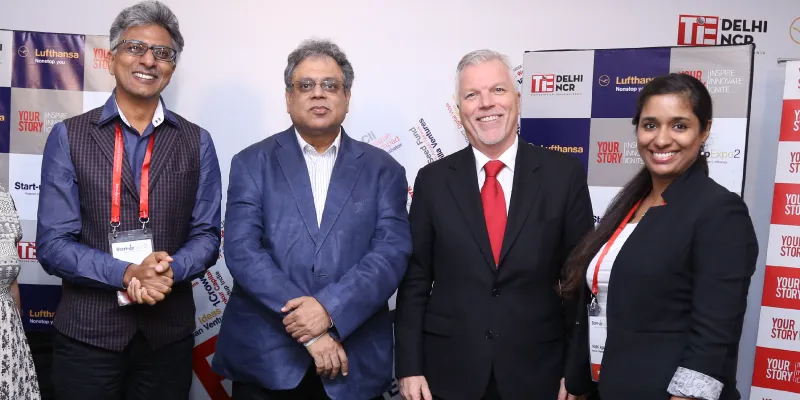What will it take to disrupt India 2? Or in which we ask, where’s the money?
When it comes to startup funding, 'golmaal hai bhai sab golmaal hai'. It is true that the straight path of entrepreneurship is often twisted. Here are some alternate investment sources you never thought about.
The answer to the above question doing the rounds is, first let’s figure out what it will take to disrupt India 1. For sure, we’ve come a long way in these 10 years.
Practically everyone I know, including my mother, is on Facebook. Women in Dharavi slums are using Whatsapp to sell handmade crafts and augmenting their income. People in towns like Indore and Madurai are shopping on Amazon and even hailing an Uber to commute to avoid congestion (never mind that the cabs have become the prime reason for the traffic snarls in the first place. But that for later.)
Of course, Google is our God. You can find anything there, even yourself. And so that you spend more time on the search platform, they have even worked it out with the government to provide the janta with Wifi at our railway platforms.

But the question to ask is where are the Indian disruptors. True, we have our Flipkarts and Olas who showed these global giants that India is ripe for tech disruption. But is that all?
How do our entrepreneurs make it possible for everyone to have easy access to healthcare, cheaper transportation, safe shelter, hygienic food, and floodless roads after a deluge?
I decided to throw this question to four people who have observed the Indian startup ecosystem evolve and been participants themselves.
Besides the usual fireworks that get ignited when investors, corporates, and entrepreneurs are pitted against each other, the interactions often throw up great insights that show where the ecosystem is headed.

On the sidelines of the fifth edition of Lufthansa Startup Expo in Gurugram last week that was bursting at the seams and had caused a traffic gridlock in Gurugram’s Udyog Vihar district, I managed to gather Sunil Goyal, Managing Director & Fund Manager at YourNest Venture Capital, Nidhi Agarwal, Founder of Kaaryah, Raman Roy, CEO of Quattro, and Wolfgang Will, Senior Director, South Asia, Lufthansa Group, for some deliberation on what is keeping startups from solving the real problems of India and how can they take this disruption to places beyond the metro cities of India.
Enablers are in place
Sunil knows more than a thing or two about how things work when an idea is pitched to investors to finally when the investors get an exit.
“The enablers are very much in place,” he begins to tell me. “Jan Dhan for bank accounts, Aadhar for digital identity, UPI is going to be revolutionising the digital payments, Jio and Airtel bringing the connectivity that we want to facilitate innovation at that level. Just wait for two, three years for the ecosystem to get a flip. We have to see some exits in the funds which have started in 2012/2015. They will be there for 2018-2020 period. The amount of capital that they will get, the disruption that is required for the India 2 and for the ventures that are not replicas of the West... will get funded at that time. Agreed, this is a painful period you (addressing Nidhi) are going through. But this is the journey of perseverance that every entrepreneur has to go through.”
Sunil should know best. He has seen three exits in the past 24 months. All three of them were unique products and concepts. One was a service (ZipDial) on a missed call bought by Twitter, the second was a video streaming on a 2G network (VuClip), where you can watch a movie without buffering in 2011 on a mobile phone bought by PCCW Hong Kong, and recently Paytm bought one company (MobiQuest).
“So exits are happening and that is what gives us hope to invest in disruptive ideas but it has to happen for thousands of other angels and VCs for the ecosystem to get a boost,” he adds.
VCs and the flavour of the month
Nidhi, being the entrepreneur in the room, had a contrarian view. “Infrastructure is a bottleneck. For example, I work out of the top business districts of Gurugram and we being a women-majority team have security as our main concern. But even if I were to leave that aside, my question is how many women-led startups get Series A funding? How many VCs would look at disruptive ideas and not just the flavour of the month?”
I was ready to get my popcorn just then. We were warming up.
“Your point is well taken,” replied Raman, popular as the pioneer of the Indian Business Process Outsourcing (BPO) industry. “Thirty years ago, when we set up the BPO industry and said we will work at night, it was unheard of. If I tell you what we went through, it will take up a lot of time. But suffice to say that now it is a standard, a given. I remember telling the transport guy that we will need 25 vehicles, he told us ‘it better work because I am putting my wife’s jewellery’. So what I am saying is that solutions have to be found. I am not saying that those solutions were the best. Yeah, it won’t happen in 12 months,” he adds.
BPO moment equivalent
As we all know the BPO model went on to spawn a $15 billion industry giving the Indian software industry a fillip. Is there an equivalent ‘BPO moment’, if you will, for the Indian startup ecosystem?
Raman is quick to respond. “I only know the point of arrival. When in a matrimonial advertisement in the papers I will see an ad that says, ‘looking for a boy working in a startup,’ then that’ll be the day. But certainly, we have covered some distance,” he says. Interjects Nidhi,
“The point of arrival, if you ask me, will be when I see an ad calling for a bride who runs her own startup.”
Wolfgang Will noticed that when Lufthansa had organised the first expo eight years ago, nobody was talking much about startups. “We started with 2000/3000 entries, today it is more than 50,000 entries,” he says.
The corporate airline that is aiming to be an enabler and contribute to the Indian startup ecosystem, facilitates mentorship sessions in the smaller towns like Hubli, Ahmedabad, Jaipur, and Kochi as part of its startup expo initiatives.
Small towns, smaller aspirations?
What are the entrepreneurs in these smaller towns and cities thinking, I wonder.
Sunil, who has in the past been a mentor on this platform, offers to respond. “I would have heard 16 pitches on stage recently. The only one for me was a fundable one from the point of view of disruption. But does that mean others were not fundable? They needed mentoring and coaching to elevate their thinking. Even this particular startup founder was thinking small in terms of revenues. We need to lift their aspirations to say that ‘do not think of venture of Rs 10 crore to Rs 100 crore opportunity. Talk of how you can bring about a change in the billion plus population of India,” says Sunil.

The conversation moves to the hiring of the right talent and whether our education system is unable to keep pace with the tech advances worldwide. We also touched upon the often unsaid fact whether it is our mindset that is keeping us from product innovation?
It is clear that there are no easy answers to any of these.
Show me the money
However, for the entrepreneurs, the important question to be addressed is why are Indian investors not risk-takers?
When we heard last, investors are sitting on nearly $8 billion of dry powder. Why is all this money not being deployed? Are there no viable ideas? Answers Sunil,
“There is a cleansing of the system happening for the last two years -- over valuations and returns not paid. It is a big cost we are paying for the economic cycle.”
He puts two main points that the government needs to absolutely do to facilitate the easy access to funding for entrepreneurs.
ALSO READ: Why Indian startups are facing a lack of vitamin C
“Most of the capital that comes into venture capital and private equity worldwide is through endowments of funds from universities and charitable institutions.Our charitable institutes, whether you take the likes of the Katra Trust, Tirupati Trust, and Amritsar Trust or other such foundations, each one of them is sitting on hundreds and thousands of long-term capital. That capital, as per the Income Tax Act can only be deployed in government securities. And I know none of these trusts will need any of this money for another 50 years or later," suggests Sunil, adding,
"My ask from the government is please allow them (the charitable trusts) to put 10/15 percent of the capital which does not belong to anyone, but the Gods, to be put into venture capital.”
An excellent point, even to my ‘un-expert’ brain.
His second suggestion, I must admit is a bit far fetched. He too admits it will bring the labour lobbies to his door baying for his blood. “I was happy to hear that the government has announced the new Wage Bill. I am not bothered about what will happen today. I want a worker to be confident that he can assure his child’s future 25 years hence,” says Sunil. His suggestion is that if every worker contributes five percent of the PF contribution towards venture capital, then “life is made. You have a huge amount of capital available for the opportunities that Nidhi is talking about. This is an opportunity to plug in that if Rs 18,000 is the minimum wage, five percent (Rs 25) of the PF contribution of Rs 500 will go towards venture capital.”
Not sure if the opportunity can come at this cost considering there are already many retail investors - people who have invested in the stock markets and real estate, or as Sunil says, “Businessmen who have the mindset of making two percent on every trade that they do. For them to understand that I will invest in a startup and get the money back in five to 10 years after she (the entrepreneur) has made a wonderful brand and a company, it doesn’t gel with them. They need to understand that just like they sell a property in 10 years and get returns, they need to sit patiently. You don’t get to see the building come up, but there’s a brand, there’s some innovation that is happening. So support that. To create exit opportunities, we have to encourage them to invest.”
Create exit opportunities
Raman makes a valid point too.
“Today, 95 percent of funds are getting money from the overseas. At India Angel Networks (of which Raman is a member), it has been difficult to get money from Indian investors.”
“You know the best story for an entrepreneur is this: ‘An investor who has invested in my company has made his money and exited when he wanted to.’ This was the story I used to hear from Sunil Mittal in 2007/2008,” adds Sunil.
So, what do we do to get there? There is a need now and the time is right for secondary funds to come to India. “These family offices and the government should enable the ecosystem to grow. There is an investor in Nidhi’s company, for example, who wants to exit after having patiently waited for three years. Can we provide her with a secondary fund?” he asks. This exit visibility will bring back capital to India, believes Sunil.
ALSO READ: Big startups gobble up little ones, but where are the big IPOs?
Interestingly, Raman questions why the government funds should come with a return on investment clause. “It should be payable when able. If the venture does not succeed, the government has the ability to write it off.”
Nidhi has the last word, not because of her gender but because her ilk is the hero of the moment. The entrepreneur will go out there and make it happen. It is to the corporates that she poses the question: Show me the money. “India has a huge corporate machinery that is ready to deploy towards startups.” Right now, they have the required firepower to ignite the rocket of entrepreneurship. And the right opportunity too, to provide investment that will walk the talk.







